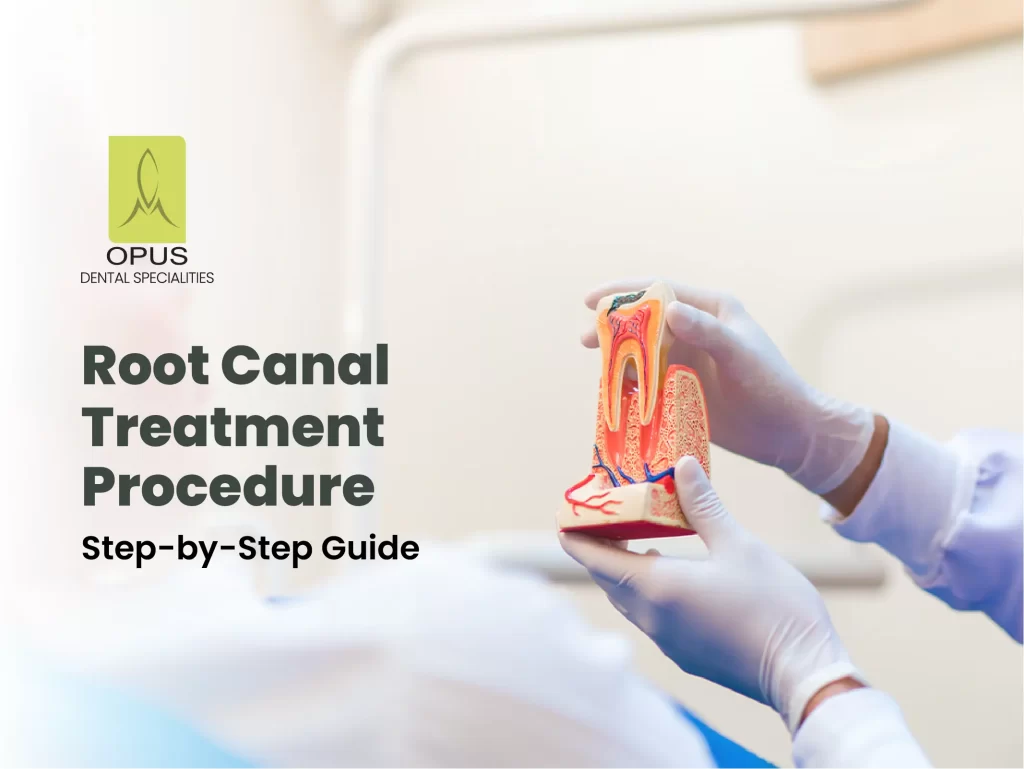
Not all heroes wear capes. Some wear dental scrubs and save teeth every single day.
If you’ve been told you need a root canal, it’s normal to feel nervous or unsure. The phrase alone can sound intimidating, but the reality is very different. Thanks to modern dental science, the root canal treatment procedure is now one of the most common and successful procedures to relieve tooth pain and preserve your natural smile.
Many people assume that tooth pain always means extraction, but that’s not true. Tooth Root canal treatment procedure helps you keep your natural tooth and avoid the long-term problems that come with missing teeth. It removes infection, stops the pain, and restores your tooth’s function so you can chew and smile comfortably again.
In this step-by-step guide to the complete root canal treatment procedure, we’ll walk you through exactly what happens during a root canal treatment. Understanding the root canal process can help you feel calm, informed, and confident in your decision.
What is Root Canal Treatment?
Root canal treatment is a dental procedure designed to save a tooth that is severely infected or decayed. When the soft inner tissue of the tooth, known as the pulp, becomes inflamed or infected due to deep cavities, repeated dental procedures, cracks, or trauma, it can lead to intense pain and sensitivity. A root canal involves removing the infected pulp, thoroughly cleaning and disinfecting the inside of the tooth, and then sealing it to prevent further damage or infection.
Contrary to common myths, root canal treatment is not a painful procedure, in fact, it is performed to relieve pain and restore the tooth’s function. With the help of modern techniques and anesthesia, the treatment is safe, effective, and usually completed in one to two visits. Preserving your natural tooth through a root canal helps maintain proper chewing, normal bite alignment, and prevents excessive wear on surrounding teeth.
For more insights, read about Root Canal Myths and see real root canal before and after transformations.
How Root Canal Treatment is Done: A Detailed Process
Tooth pain that lingers, sensitivity to hot or cold drinks, and swelling around a tooth are warning signs that something deeper may be wrong. These symptoms often point to a problem inside the tooth, where the soft tissue or pulp resides. When this pulp gets infected due to cavities, injury, or a cracked tooth, it can become extremely painful.
Without treatment, the infection may spread to nearby tissue or bone. Eventually, it can lead to an abscess, severe discomfort, and even tooth loss. A root canal procedure helps prevent all of this by removing the infected tissue and saving the healthy outer tooth structure.
Step 1: Consultation and Diagnosis
The first step starts with a detailed dental exam. Your dentist will ask about your symptoms and examine the tooth closely. X-rays are used to check the roots of the tooth and surrounding bone.
At Opus Dental Specialities, our team uses digital imaging and advanced diagnostic tools to confirm whether rct teeth treatment is necessary. The focus is not just on the problem tooth but also on your overall comfort, safety, and oral health.
Step 2: Numbing the Tooth
To make sure you feel no discomfort during the procedure, the dentist applies a local anesthetic to numb the affected area. This ensures the treatment is pain-free from start to finish.
If you feel nervous or anxious about dental work, sedation options can be discussed beforehand. At Opus Dental, your comfort matters just as much as your treatment outcome.
Step 3: Isolating the Tooth
To keep the area clean, a small protective sheet called a dental dam is used to isolate the tooth. This keeps out saliva and bacteria during the procedure. It also helps the dentist work more efficiently by keeping the tooth dry and clearly visible throughout the process.
Step 4: Making an Opening in the Tooth
Using a small dental drill, the dentist creates a tiny opening on the surface of the tooth. This opening allows access to the infected pulp chamber inside.
Once the tooth is opened, the dentist can clearly see and reach the canals that run through the roots. This is where the real root canal treatment steps and repair begins.
Step 5: Removing the Infected Pulp and Cleaning the Canals
Inside each tooth is a soft tissue called pulp, which contains nerves and blood vessels. When this pulp is infected or inflamed, it must be removed. The dentist uses special tools to carefully remove the infected tissue from inside the canals.
After the pulp is removed, the canals are cleaned thoroughly using antibacterial solutions. This is important to make sure all the bacteria are eliminated and there’s no risk of reinfection. These are essential steps of root canal treatment procedure.
Step 6: Shaping and Filling the Canals
This phase is critical in the root canal treatment process. Once the canals are cleaned, they are shaped using flexible instruments to prepare them for filling. Shaping ensures the canals can be sealed tightly and securely.
The canals are then filled with a soft, rubber-like material called gutta-percha. This filling seals the inside of the tooth and prevents any future infection. A temporary filling is placed over the tooth to close it until the permanent crown is ready.
Step 7: Placing the Permanent Crown or Restoration
After a few days, you’ll return for the final restoration. In most cases, a dental crown is placed over the tooth to restore its strength, shape, and appearance. This crown protects the tooth from future damage and allows you to chew comfortably.
Opus Dental Specialities offers custom-made crowns that match your natural teeth in shape and color. The result is a restored tooth that feels and looks completely natural. This concludes the complete root canal treatment procedure.
Root Canal Recovery and Aftercare
Pain after root canal treatment procedure is usually minimal. Root canal treatment has a short recovery time. You may feel mild soreness or tenderness for a day or two, which is completely normal. Over-the-counter pain relievers usually work well to manage this.
To ensure smooth healing:
- Avoid chewing on the treated side until the permanent crown is placed
- Maintain good oral hygiene with gentle brushing and flossing
- Follow all instructions given by your dentist
- Return for follow-up appointments as scheduled
With proper care, a tooth treated with a root canal can last a lifetime.
Why Root Canal is Better Than Tooth Extraction?
Many patients ask whether it’s better to just remove the tooth. The truth is, keeping your natural tooth whenever possible is always the best option. Here’s why:
- A natural tooth maintains proper bite and jaw function
- It prevents surrounding teeth from shifting
- It avoids bone loss in the jaw
- You don’t need replacement options like bridges or implants
- It helps maintain facial shape and structure
Saving your tooth also helps preserve the comfort and confidence of your natural smile. For comparison, explore the benefits of Single-Sitting RCT.
When to Contact Your Dentist After a Root Canal?
Though rare, complications can occur if aftercare instructions aren’t followed. Contact your dentist if you experience:
- Severe pain that worsens after a few days
- Swelling in the gums or face
- A cracked or broken temporary filling
- Bleeding or discharge around the treated tooth
Timely attention can help address any concerns and avoid complications.
Final Thoughts
What is the procedure of root canal treatment? It’s not something to fear; it is something to appreciate. It allows you to keep your natural tooth, relieve pain, and return to your normal routine without the discomfort and inconvenience of missing teeth.
Thanks to gentle techniques, skilled professionals, and modern dental technology, getting a root canal treatment procedure today is smoother and more comfortable than ever before.
At Opus Dental Specialities, we’re committed to preserving your natural teeth with the highest level of care and precision. If you’re in pain or have been advised to get an rct treatment, don’t wait.
Book your appointment now and take the first step toward a healthy, pain-free smile.
Read more blogs:
